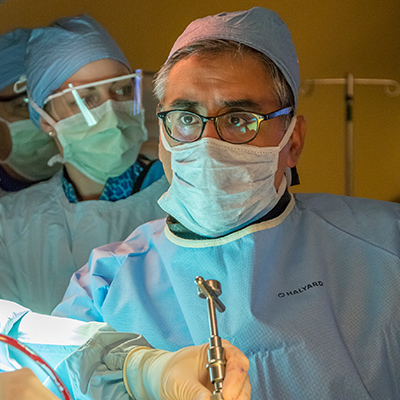Bringing Disruptive Innovation to the Front Lines of Care Delivery
Virginia Mason spine surgeon, Rajiv Sethi, MD, speaks about why there should be greater urgency to improve the delivery of health care.
The U.S. health care system, and many other health systems around the world, are buckling under the overarching pressures to cut costs, improve quality, and expand access. While changing government policies add to the stress, they are not the answer to fixing a wasteful system or the poor processes that have become status quo.

Once skeptical of Virginia Mason’s innovative management system and improvement tools, Rajiv Sethi, MD, director of the Neuroscience Institute at Virginia Mason and a complex spinal surgeon, has now become a champion of applying Virginia Mason’s lean methods to improve clinical and cultural value streams in the health care space. As a result of his team’s success driving change, they managed to reduce the number of surgical complications in patients by 36 percent. He shares his account of the impacts that have stemmed from engaging his own team in doing this work.
“What has been done differently here at Virginia Mason is how we utilize things like lean methodology, team-based methods, and taking more of a disruptive approach to these operations and the entire care of patients to improve outcomes,” says Sethi. “We made some significant gains in the last decade around the care of spine patients in terms of reducing complication rates and returns to the OR. Additionally, this has decreased infection rates, and increased patient satisfaction. These improvements show forward movement around some of these critical areas, particularly on delivering a more reliable outcome, where we can begin to think about warranting or guaranteeing some of our work.”
A systems-engineering approach to operational improvement has helped Sethi, who is charged with developing and building a service line around spine care, to figure out which strategies were needed to place locally in his own environment to deliver better outcomes and provide more of an enhanced product and guarantee for the work they are doing. Beyond this, he says, “It also helped to inform particularly what strategies we needed to deploy with our physicians to get buy-in and to transform this space to deliver a much more predictable result.”
To those who are skeptical of being able to successfully transfer these methods to their own organization, Sethi says, “I think it is totally reasonable to be skeptical about this work because it is transformative. Much of our published research shows you that this work can be transformative for the entire team, and particularly for the patients involved who we serve,” adding, “The skepticism should not be met with a sense of defeat. If you truly feel that transforming your care pathways is not possible, that is a truly sad assessment of the current state at your organization.” The essential parts of Virginia Mason’s management system are transferable and applicable to any health care organization.
Health systems need trailblazers, from the bottom up, to inspire and drive the work to achieve meaningful and sustainable change. From the boardroom to the front lines of care delivery — disruptive innovation of processes, methods, and mindsets is critical to gaining a competitive advantage in the health care market and providing patients access to higher quality care with fewer delays and more value-added services. Using team-based strategies creates a pathway for executive leaders to empower clinicians to make better decisions for patients and achieve better outcomes across many complex and intersecting service lines, such as spinal surgery.
“I feel it is my role to empower others. The way that I do that is by creating as transparent and direct of an approach as possible, particularly in the care of these complex patients. That involves allowing other people to question your judgement in open forums like multi-disciplinary conferences, and taking an operation that I can easily do myself, and take a lot longer to do, and involving another surgeon so that we cut the time down and deliver the surgical result in a much more predictable fashion. It involves me being able to stand in front of my team and openly take advice on how we can make things better.”
Rajiv Sethi, MD
The innovative approach at Virginia Mason provides health care executives and clinical leaders with a reliable framework to put their team together: the practicing clinicians, the nurses, the physician’s assistants, the residents and fellows, administrative and executive leaders. A team-based approach means that together, and bit by bit, the team drills down on what is needed in their situation to achieve change. This current state insight, ultimately, provides the groundwork needed to start the journey to the future vision.
Speaking as a clinical leader, charged with engaging his team, Sethi adds, “I feel it is my role to empower others. The way that I do that is by creating as transparent and direct of an approach as possible, particularly in the care of these complex patients. That involves allowing other people to question your judgement in open forums like multi-disciplinary conferences, and taking an operation that I can easily do myself, and take a lot longer to do, and involving another surgeon so that we cut the time down and deliver the surgical result in a much more predictable fashion. It involves me being able to stand in front of my team and openly take advice on how we can make things better. A lot of this involves connecting with your team in a different way and that is something that is championed by our management method, something that involves respect for people, something that involves walking on the floor, or what we call the genba, and figuring out what the frontline staff and people need to make better care decisions.”
“If we charge ourselves as leaders to do something about it we have to completely disrupt this space and move towards a very different paradigm of care – and that’s what we are doing here at Virginia Mason,” shares Sethi.





